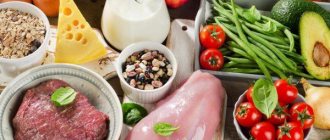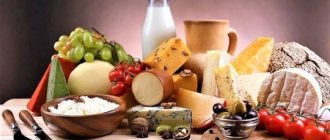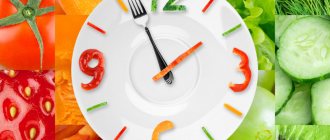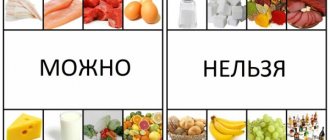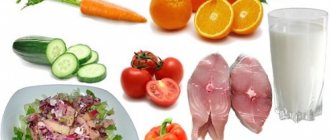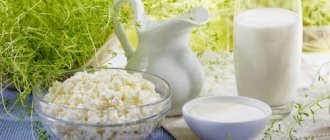General rules
Calcium is the main component of the body and the importance of this trace element has been proven. At all stages of life, many different processes occur: contraction and relaxation of blood vessels and muscles, transmission of nerve signals, intracellular and hormonal secretion. And any change in serum calcium levels can affect one or more of these functions. The daily calcium requirement for an adult is about 1200 mg per day or more ( menopause and osteoporosis ).
When consumed with food, absorption is approximately 30%, and the rate of absorption varies widely. So during pregnancy it increases, and during the aging process of a person it progressively decreases. The average intake of this element from food is 1000 mg per day, but only 200 mg is absorbed in the intestines, and the rest is excreted in the feces. The element is absorbed from the upper parts of the small intestine, but this requires the presence of vitamin D , lactose, and ascorbic acid . Absorption is significantly reduced in the presence of diseases of the gastrointestinal tract ( peptic ulcer , colitis , cholelithiasis , hepatitis ).
With a deficiency of this element, neurological symptoms are observed: numbness and paresthesia , behavioral disturbances, convulsions , muscle spasms, hydrocephalus , vitamin D-deficient rickets (in young children), osteoporosis (in the elderly).
Risk groups for microelement deficiency:
- Pregnant and lactating women.
- Postmenopausal women . In children and young people, bone turnover is characterized by rapid growth and skeletal formation. After 25 years, the formation of bone tissue is completed and metabolism switches to the mode of maintaining density and structure. Starting at age 50, bone density decreases, which inevitably leads to osteoporosis and fractures.
- Athletes performing intense physical activity.
- Patients with an allergy to milk protein, as well as lactose intolerance (due to the sharp limitation or exclusion of dairy products in the diet).
- Individuals with insufficient calcium intake (teenagers and older adults).
- Patients with psoriasis and gastrointestinal diseases.
- In the presence of fractures and joint diseases;
- Wearing braces.
In order to correct microelement deficiency, individuals at risk are prescribed a diet enriched with calcium. A diet rich in calcium is also indicated for diseases of the cardiovascular system. It is known that arterial hypertension , atherosclerosis , and circulatory failure are calcium-dependent diseases. The basic principles of nutrition are simple - ensure sufficient daily intake of microelements and vitamins that facilitate their absorption in the intestines and minimize factors that impede this process.
Calcium diet includes:
- Milk, fermented milk products.
- Vegetables, fruits and nuts (listed with the highest content): parsley, garlic, dill, persimmons, dried apricots, celery greens, dandelion leaves, lettuce, green onions, leeks, watercress, cilantro.
- Protein of animal and plant origin (lean meat, legumes).
- Vitamin D ensures complete absorption of calcium from the small intestine. Its daily dose should be 800 IU. Vitamin D3 vitamin D2 is absorbed in the gastrointestinal tract with food .
- Sources of this vitamin: sea bass, herring, tuna, mackerel, seafood, fish liver (halibut and cod), fish oil, cheese, sour cream, cocoa, eggs.
- Magnesium reduces calcium loss in urine. A sufficient amount of it is found in peas, oatmeal, walnuts, beans, mustard and buckwheat.
- Zinc - improves calcium absorption and accelerates bone mineralization. The need for it increases several times. Sunflower seeds, chicken hearts, peanuts, shrimp, pine nuts, soybeans, seaweed, and cheeses are rich in zinc. The calcium-magnesium-zinc triad and vitamin D be essential for osteoporosis .
- Foods containing folic acid (green vegetables, legumes, broccoli, asparagus, avocado, Brussels sprouts, sunflower seeds, flax seeds, almonds, peanuts and vitamin B6 (pine nuts, beans, walnuts, tuna, mackerel, beef and chicken liver, sardines ).
- Potassium - reduces the excretion of calcium from the body, so it is advisable to include foods rich in it: dried apricots, beans, seaweed, peas, prunes, raisins, hazelnuts, almonds, lentils, peanuts.
A table of calcium content in foods will help you choose foods high in calcium and create a diet.
| Product | Microelement content per 100 g |
| Sesame seed | 1474 mg |
| "Parmesan" | 1184 mg |
| Powdered milk | 1155 mg |
| Dutch, Poshekhonsky and Cheddar cheese | 1000 mg |
| Russian cheese | 880 mg |
| Gouda cheese | 700 mg |
| Sulguni cheese | 650 mg |
| Adyghe cheese | 520 mg |
| Sunflower seeds | 367 mg |
| Soybean (dried grain) | 348 mg |
| Sprats in oil | 300 mg |
| Almond | 273 mg |
| Parsley | 245 mg |
| Dill greens | 223 mg |
| Chickpeas | 193 mg |
| Mash | 192 mg |
| Hazelnut | 188 mg |
| Pink salmon (canned) | 185 mg |
| Garlic | 180 mg |
| Cottage cheese 4%, 5%, 9% | 164 mg |
| Dried apricots | 160 mg |
| Beans (grain, dried) | 150 mg |
| Figs | 144 mg |
| Goat milk | 134 mg |
| Persimmon | 127 mg |
| Low-fat kefir, milk and yogurt | 126 mg |
| Ryazhenka and yogurt | 124 mg |
| Whole grain bread | 107 mg |
| Spinach | 106 mg |
| Pistachios | 105 mg |
| Green onion | 100 mg |
| Peas (dried) | 89 mg |
| Walnut | 89 mg |
| Sour cream 15% | 88 mg |
| Cream 20% | 86 mg |
| Lentils (grain, dried) | 83 mg |
| Watercress | 81 mg |
| Raisins, prunes | 80 mg |
| Lettuce, Chinese cabbage | 77 mg |
| Peanut | 76 mg |
| Cilantro | 67 mg |
| Dates | 65 mg |
| Oatmeal | 64 mg |
| Red cabbage | 53 mg |
| Turnip | 49 mg |
| White cabbage | 48 mg |
| Sorrel, broccoli | 47 mg |
| Red rowan | 42 mg |
| Rice | 40 mg |
| Sea kale | 40 mg |
| Kiwi, raspberries, strawberries | 40 mg |
| Radish | 39 mg |
| Beet | 37 mg |
| Cherry | 37 mg |
| Currants of all types | 36 mg |
| Mandarin | 35 mg |
| Orange | 34 mg |
| Cherries | 33 mg |
| Grapes, blackberries | 30 mg |
| Chokeberry, apricot | 28 mg |
| Carrot | 27 mg |
| Cherry plum | 27 mg |
| Pumpkin | 25 mg |
| Cucumber | 23 mg |
| Grapefruit | 23 mg |
| Sea buckthorn, gooseberry | 22 mg |
| Asparagus | 21 mg |
| Buckwheat, corn, semolina | 20 mg |
| Papaya, peach | 20 mg |
| Pear | 19 mg |
| Feijoa | 17 mg |
| Apples, melon | 16 mg |
| Eggplants, zucchini, savoy cabbage | 15 mg |
| Tomato | 14 mg |
| Potato | 10 mg |
| Sweet pepper | 8 mg |
For convenience, the table of calcium in food products is built on the principle of decreasing content of this microelement.
Contraindications
Excess calcium in the diet has an adverse effect in the presence of the following conditions:
- hypercalcemia (increased levels of calcium ions in the blood);
- hypercalciuria (increased excretion of calcium by the kidneys);
- severe renal filtration failure;
- urolithiasis disease;
- established excess of vitamin D in the blood;
- active phase of tuberculosis;
- thrombophlebitis, widespread atherosclerosis, tendency to thrombosis;
- use of cardiac glycosides.
Hypercalcemia
Before prescribing a calcium diet, the doctor recommends laboratory and instrumental examination. This type of diet is therapeutic and cannot be recommended to all patients without exception; contraindications to its use should be taken into account.
Authorized Products
Calcium-rich foods included in the diet:
- Milk and fermented milk products: cottage cheese, kefir, fermented baked milk, cheeses, sour cream. Moreover, the higher their fat content, the lower the microelement content. It is believed that to meet the requirement for this micronutrient, you need to consume more than three servings of dairy products daily.
- One serving is considered to be 30 g of cheese, 200 ml of milk (kefir, yogurt), 100 g of cottage cheese, 150 g of yogurt.
- If a person consumes only 1-2 servings, it is necessary to ensure that 600 mg of calcium is taken in the form of the drug. If not consumed at all, then 1200 mg in tablet form.
- Soy and soy products (milk, yogurt, tofu).
- Fish, seafood (especially shrimp), canned fish (sardines in oil, sprats, pink salmon), sprat, anchovy.
- Vegetables - lentils, peas, chickpeas, mung beans, beans, dill, parsley, green onions, lettuce, celery, olives, garlic, red and white cabbage, broccoli. They are best consumed fresh.
- Dried fruits (dried apricots, figs, persimmons, raisins, prunes, dates) can be used as a snack, added to all fruit salads and cottage cheese, or consumed with kefir.
- Seeds and sunflower seeds (sesame seeds, pumpkin seeds and sunflower seeds) and nuts (hazelnuts, pistachios, walnuts, almonds).
- Of all grains, rice has the highest calcium content, but this does not mean that you should only eat it.
Using the table above, you can create a daily diet with a complete content of this microelement.
Table of permitted products
| Proteins, g | Fats, g | Carbohydrates, g | Calories, kcal | |
Vegetables and greens | ||||
| vegetables legumes | 9,1 | 1,6 | 27,0 | 168 |
| zucchini | 0,6 | 0,3 | 4,6 | 24 |
| Brussels sprouts | 4,8 | 0,0 | 8,0 | 43 |
| sauerkraut | 1,8 | 0,1 | 4,4 | 19 |
| cauliflower | 2,5 | 0,3 | 5,4 | 30 |
| bulb onions | 1,4 | 0,0 | 10,4 | 41 |
| carrot | 1,3 | 0,1 | 6,9 | 32 |
| cucumbers | 0,8 | 0,1 | 2,8 | 15 |
| pickles | 0,8 | 0,1 | 1,7 | 11 |
| beet | 1,5 | 0,1 | 8,8 | 40 |
| celery | 0,9 | 0,1 | 2,1 | 12 |
| tomatoes | 0,6 | 0,2 | 4,2 | 20 |
| pumpkin | 1,3 | 0,3 | 7,7 | 28 |
| garlic | 6,5 | 0,5 | 29,9 | 143 |
Fruits | ||||
| apricots | 0,9 | 0,1 | 10,8 | 41 |
| avocado | 2,0 | 20,0 | 7,4 | 208 |
| oranges | 0,9 | 0,2 | 8,1 | 36 |
| watermelon | 0,6 | 0,1 | 5,8 | 25 |
| bananas | 1,5 | 0,2 | 21,8 | 95 |
| pears | 0,4 | 0,3 | 10,9 | 42 |
| melon | 0,6 | 0,3 | 7,4 | 33 |
| lime | 0,9 | 0,1 | 3,0 | 16 |
| lemons | 0,9 | 0,1 | 3,0 | 16 |
| tangerines | 0,8 | 0,2 | 7,5 | 33 |
| plums | 0,8 | 0,3 | 9,6 | 42 |
| persimmon | 0,5 | 0,3 | 15,3 | 66 |
| apples | 0,4 | 0,4 | 9,8 | 47 |
Berries | ||||
| cowberry | 0,7 | 0,5 | 9,6 | 43 |
| grape | 0,6 | 0,2 | 16,8 | 65 |
| strawberry | 0,8 | 0,4 | 7,5 | 41 |
| cranberry | 0,5 | 0,0 | 6,8 | 26 |
| sea buckthorn | 1,2 | 5,4 | 5,7 | 82 |
| currant | 1,0 | 0,4 | 7,5 | 43 |
| rose hip | 1,6 | 0,0 | 14,0 | 51 |
Nuts and dried fruits | ||||
| raisin | 2,9 | 0,6 | 66,0 | 264 |
| dried apricots | 5,2 | 0,3 | 51,0 | 215 |
| dates | 2,5 | 0,5 | 69,2 | 274 |
| prunes | 2,3 | 0,7 | 57,5 | 231 |
Cereals and porridges | ||||
| buckwheat (kernel) | 12,6 | 3,3 | 62,1 | 313 |
| cereals | 11,9 | 7,2 | 69,3 | 366 |
| corn grits | 8,3 | 1,2 | 75,0 | 337 |
| pearl barley | 9,3 | 1,1 | 73,7 | 320 |
| millet cereal | 11,5 | 3,3 | 69,3 | 348 |
| white rice | 6,7 | 0,7 | 78,9 | 344 |
| barley grits | 10,4 | 1,3 | 66,3 | 324 |
Raw materials and seasonings | ||||
| honey | 0,8 | 0,0 | 81,5 | 329 |
| milk sauce | 2,0 | 7,1 | 5,2 | 84 |
| sour cream sauce | 1,9 | 5,7 | 5,2 | 78 |
Dairy | ||||
| milk 1.5% | 2,8 | 1,5 | 4,7 | 44 |
| kefir 1% | 2,8 | 1,0 | 4,0 | 40 |
| sour cream 15% (low fat) | 2,6 | 15,0 | 3,0 | 158 |
| curdled milk | 2,9 | 2,5 | 4,1 | 53 |
| acidophilus | 2,8 | 3,2 | 3,8 | 57 |
| yogurt | 4,3 | 2,0 | 6,2 | 60 |
Cheeses and cottage cheese | ||||
| cottage cheese 0.6% (low fat) | 18,0 | 0,6 | 1,8 | 88 |
Meat products | ||||
| boiled beef | 25,8 | 16,8 | 0,0 | 254 |
| boiled veal | 30,7 | 0,9 | 0,0 | 131 |
| rabbit | 21,0 | 8,0 | 0,0 | 156 |
Bird | ||||
| boiled chicken | 25,2 | 7,4 | 0,0 | 170 |
| turkey | 19,2 | 0,7 | 0,0 | 84 |
Eggs | ||||
| chicken eggs | 12,7 | 10,9 | 0,7 | 157 |
Fish and seafood | ||||
| dried fish | 17,5 | 4,6 | 0,0 | 139 |
| smoked fish | 26,8 | 9,9 | 0,0 | 196 |
| canned fish | 17,5 | 2,0 | 0,0 | 88 |
Oils and fats | ||||
| corn oil | 0,0 | 99,9 | 0,0 | 899 |
| linseed oil | 0,0 | 99,8 | 0,0 | 898 |
| olive oil | 0,0 | 99,8 | 0,0 | 898 |
| sunflower oil | 0,0 | 99,9 | 0,0 | 899 |
| ghee | 0,2 | 99,0 | 0,0 | 892 |
Non-alcoholic drinks | ||||
| mineral water | 0,0 | 0,0 | 0,0 | — |
| lingonberry juice | 0,1 | 0,0 | 10,7 | 41 |
| green tea | 0,0 | 0,0 | 0,0 | — |
Juices and compotes | ||||
| apricot juice | 0,9 | 0,1 | 9,0 | 38 |
| carrot juice | 1,1 | 0,1 | 6,4 | 28 |
| pumpkin juice | 0,0 | 0,0 | 9,0 | 38 |
| rose hip juice | 0,1 | 0,0 | 17,6 | 70 |
| * data is per 100 g of product | ||||
Nuances
- It is advisable not to drink liquids rich in caffeine and tannins. Preferred water is slightly acidified with lemon, mineral (calcium) water, fruit juices (for example, orange).
- Vegetables and fruits should be consumed raw whenever possible.
- There are no special recommendations on cooking methods, food temperatures and diet - it is enough to follow the general recommendations for a healthy diet.
Expert: Natalia Dolgopolova, general practitioner Author: Natalia Bakatina
The material uses photographs belonging to shutterstock.com
Fully or partially limited products
Products that interfere with absorption should be excluded:
- Containing oxalic acid (spinach, sorrel, gooseberries, currants, rhubarb).
- Phytic acid , which is found in legumes, bran and cereals. High levels of phytic acid in rye and rye flour (it is used only for sourdough). To reduce its content in these products, they must be soaked. Soaking allows the enzymes to break down the phytic acid. Soaking in warm, slightly acidified water for 7 hours is enough. The lactic acid bacterium lactobacilli produces the enzyme phytase , which destroys this acid. Therefore, a person with a healthy microflora is not afraid of excess phytic acid. The introduction of lacto-fermented vegetables (sauerkraut, cucumbers and tomatoes) into the diet allows you to combat its excess. The enzyme phytase activates germination, so sprouted grains that have a low phytic acid content are healthier.
- Refined flour and baked goods and white rice contain less phytic acid than brown rice and rye bread. It is important to reduce the intake of phytic acid during pregnancy , breastfeeding and osteoporosis .
- Fatty foods, fats, butter, margarine, mayonnaise, concentrated fatty broths, as they significantly impede absorption.
- Alcoholic drinks, carbonated drinks.
- Dishes rich in phosphorus (dried mushrooms, pumpkin seeds, wheat germ, baked pumpkin, bran, poppy seeds, milk powder; you should not get carried away with meat dishes, but do not exclude them completely).
- Tannins (tea, sloe, dogwood, quince, persimmon, some varieties of pear, blueberry, black currant, rowan, coffee, bay leaf) - their excessive consumption is not recommended;
- Excess fiber and dietary fiber from cereals and legumes, cereals, beans, peas, peanuts, bread and bran.
- Caffeine-containing drinks (cocoa, coffee, strong tea), chocolate.
- Significantly limit salt and sugar.
The predominance of acidic foods in the diet (meat, bread, cereals) leads to the excretion of this microelement in the urine. Hence the need to limit them and switch to a predominantly plant-based dairy diet.
Table of prohibited products
| Proteins, g | Fats, g | Carbohydrates, g | Calories, kcal | |
Vegetables and greens | ||||
| swede | 1,2 | 0,1 | 7,7 | 37 |
| radish | 1,2 | 0,1 | 3,4 | 19 |
| white radish | 1,4 | 0,0 | 4,1 | 21 |
| horseradish | 3,2 | 0,4 | 10,5 | 56 |
| sorrel | 1,5 | 0,3 | 2,9 | 19 |
Confectionery | ||||
| jam | 0,3 | 0,2 | 63,0 | 263 |
| jam | 0,3 | 0,1 | 56,0 | 238 |
| cake | 3,8 | 22,6 | 47,0 | 397 |
Chocolate | ||||
| chocolate | 5,4 | 35,3 | 56,5 | 544 |
Raw materials and seasonings | ||||
| mustard | 5,7 | 6,4 | 22,0 | 162 |
| ketchup | 1,8 | 1,0 | 22,2 | 93 |
| mayonnaise | 2,4 | 67,0 | 3,9 | 627 |
| ground black pepper | 10,4 | 3,3 | 38,7 | 251 |
| sugar | 0,0 | 0,0 | 99,7 | 398 |
| soy sauce | 3,5 | 0,0 | 11,0 | 58 |
| vinegar | 0,0 | 0,0 | 5,0 | 20 |
Meat products | ||||
| pork | 16,0 | 21,6 | 0,0 | 259 |
Bird | ||||
| smoked chicken | 27,5 | 8,2 | 0,0 | 184 |
| duck | 16,5 | 61,2 | 0,0 | 346 |
| smoked duck | 19,0 | 28,4 | 0,0 | 337 |
| goose | 16,1 | 33,3 | 0,0 | 364 |
Oils and fats | ||||
| animal fat | 0,0 | 99,7 | 0,0 | 897 |
| cooking fat | 0,0 | 99,7 | 0,0 | 897 |
Non-alcoholic drinks | ||||
| cola | 0,0 | 0,0 | 10,4 | 42 |
| lemonade | 0,0 | 0,0 | 6,4 | 26 |
| Pepsi | 0,0 | 0,0 | 8,7 | 38 |
| sprite | 0,1 | 0,0 | 7,0 | 29 |
| black tea | 20,0 | 5,1 | 6,9 | 152 |
Juices and compotes | ||||
| tomato juice | 1,1 | 0,2 | 3,8 | 21 |
| * data is per 100 g of product | ||||
Legumes
Legumes such as beans and lentils contain significant amounts of fiber, protein and micronutrients. They also boast high amounts of iron, zinc, folic acid, magnesium and potassium. Some varieties are also rich in calcium.
Winged beans have the highest amount of calcium among legumes. A 200 gram serving of cooked winged beans contains 184 mg of calcium, which is 18% of the RDI ().
White beans are also a good source of calcium - a 200g serving of cooked white beans contains 146mg of this mineral, which is 14% of the RDI. Other beans and lentils contain lower amounts of this mineral - 4-6% of the RDI per serving (, ,).
Research shows that legumes may help lower LDL cholesterol ("bad cholesterol") and reduce the risk of developing type 2 diabetes ().
Summary:
Legumes are highly nutritious, and one 200 gram serving of cooked winged beans provides 24% of the RDA for calcium.
Menu (Power Mode)
Knowing the daily requirement for calcium, you can create a varied and balanced diet from allowed foods. It should be based on dairy products, fish, seafood, vegetables, fruits and nuts. Sesame seeds should be present in your diet every day. Against the background of the main diet, it is enough to consume 2 tsp. three times a day. For better digestibility, it is better to grind the seed, since it has a hard shell that makes absorption difficult.
| Breakfast |
|
| Lunch |
|
| Dinner |
|
| Afternoon snack |
|
| Dinner |
|
| For the night |
|
| Breakfast |
|
| Lunch |
|
| Dinner |
|
| Afternoon snack |
|
| Dinner |
|
| For the night |
|
| Breakfast |
|
| Lunch |
|
| Dinner |
|
| Afternoon snack |
|
| Dinner |
|
| For the night |
|
Seeds
Seeds are tiny nutritional powerhouses. Some contain calcium, such as poppy seeds, sesame seeds, celery and chia seeds.
For example, 1 tablespoon (15 grams) of poppy seeds contains 126 mg, or 13% of the RDA for calcium ().
The seeds also contain proteins and healthy fats. For example, chia seeds are a rich source of plant-based omega-3 fatty acids ().
1 tablespoon of sesame seeds contains 9% of the RDA for calcium. Sesame also contains other minerals including copper, iron and manganese ().
Summary:
Several types of seeds are good sources of calcium. For example, 1 tablespoon of poppy seeds contains 13% of the RDA for this mineral.
Reviews and results
A calcium diet compensates for the deficiency of the trace element Ca, and in some conditions such changes in the diet are sufficient. This diet is not monotonous and does not have any special restrictions, so it is easily tolerated and suitable for constant implementation. It provides the body with essential nutrients and vitamins. In some cases, an adequate dose of calcium is prescribed. For example, taking 1 g in the evening for postmenopausal osteoporosis reduces bone resorption. Evening administration is most effective and is due to the fact that maximum resorption occurs in the morning.
- “... I was treated in the department with a severe fracture. X-rays additionally revealed signs of osteoporosis, so the doctor told me to eat foods containing calcium. I noticed that for the last six months I have been craving dairy products, I ate them, but it was not enough. In the hospital, for rapid and high-quality healing of the fracture, the drug Osteokea was prescribed for 2 months. They told me to take it once a quarter. It was already convenient to create proper nutrition at home. I studied all the products and began to eat sesame seeds, dairy products, nuts (especially almonds and hazelnuts), dried apricots, and figs every day. In winter I like to eat persimmons. Twice a week I ate canned fish - the bones in them are soft and contain the necessary element”;
- “... During pregnancy I noticed severe hair loss and brittle nails, and after 12 weeks the tooth began to crumble. In addition to cottage cheese and fermented milk products, I ate a handful of greens, dried apricots, and almonds. The doctor also recommended Elevit - a very good drug that helped me cope with these problems. It contains all the necessary microelements and vitamins. However, the child still had a lack of calcium - the daughter had soft bones”;
- “... Still, nutrition and vitamins play an important role during pregnancy. I felt this myself and still feel it. During my second pregnancy I did not eat cottage cheese and did not take calcium tablets. As a result, I developed postpartum osteoporosis and a vertebral fracture. The child was then 4 months old. And it happened simply because I held a child in my arms. I wore a corset and was forbidden to pick up a child (you can imagine how this is possible) and to lift weights. It's been a year now, but I have back pain every day, which gets worse after doing any housework. This is very stressful, since I have two children and of course I have a full-time job. During my first pregnancy I took Elevit prenatal and Calcium D3 Nycomed.”
Who is the calcium diet indicated for?
Recommendations for therapeutic nutrition should be followed when a diagnosis of osteoporosis is established, but its prevention for patients at risk is equally important. These may include patients with the following data:
- hereditary predisposition to decreased bone density (fractures of the femoral neck, radius above the joint, vertebrae in close relatives from minor trauma);
- age after 50 years;
- women at the onset of menopause; Osteoporosis
- weight up to 55 kg for women and up to 70 for men;
- height from 172 cm (women) and 183 cm (men);
- asthenic (thin) build, narrow hands and wrists, long fingers;
- hormonal imbalance, especially decreased testicular and ovarian function, rare sexual activity, infertility, increased function of the parathyroid glands, diabetes mellitus, thyrotoxicosis, hyperprolactinemia;
- early menopause, surgery to remove the ovaries;
- late puberty, periods of cessation of menstruation outside of pregnancy and menopause;
- smoking, alcoholism, coffee addiction;
- low physical activity, prolonged bed rest;
- living in the northern regions, permanent stay indoors;
- the use of analogues of hormones of the adrenal glands, thyroid gland, anticoagulants, anticonvulsants and cytostatics.
We recommend reading the article about osteoporosis. From it you will learn about what osteoporosis is, the stages of the disease, early signs of bone osteoporosis, options for the initial stage, how you can suspect osteoporosis and clinical options for osteoporosis.
And here is more information about tests for osteoporosis.
Symptoms of osteoporosis
In the initial stages, the disease may occur without symptoms. The beginning of the development of pathology can be indicated by a changed posture and decreasing height. In the second case, you just need to measure your height and compare it with what it was at the age of 20-25.
As the disease progresses, the following symptoms appear:
- Pain during compression loads - lifting heavy objects, falling, sharp turns of the body. After 4-6 weeks, the pain may subside. If multiple microfractures of the spine are present, the pain syndrome worsens when coughing, sneezing, laughing, or changing body position.
- Significant reduction in height – up to 15 cm.
- Reduced chest volume, visually too long upper limbs.
- Deformation of the spine, poor posture, formation of a hump.
- Soreness of the affected bones on palpation.
- Cramps in the limbs.
- Common symptoms of calcium loss are deterioration of teeth, hair and nails.
- Pain after prolonged standing or sitting.
- Soreness, weakness, numbness in the hands.
- Headache.
- Blood pressure surges.
How is calcium absorbed?
Calcium is absorbed in the intestines: it enters the cells, passes through them and is released into the blood. On this path, it is helped by calcitriol, the active form of vitamin D. It increases the penetration of calcium into intestinal cells, speeds up its transfer and release.
Insulin-like growth factor 1 is required for vitamin D to be converted into calcitriol, and protein is required to produce it. The study Dietary protein, calcium metabolism, and skeletal homeostasis revisited showed that increasing the amount of protein in the diet three times (up to 2.1 g per 1 kg of weight) increases the absorption of calcium in the intestines by 8%.
Thus, along with calcium, you should consume enough protein, and also get more sun exposure or choose foods rich in vitamin D.
| Calcium, mg per day | Protein, g per day | Vitamin D, mcg per day |
| 1 000–1 200 | 65–117 for men 58–87 for women | 10 |
Almond
Among all nuts, almonds are the richest in calcium. Just 100 g of almonds contain 266 mg of calcium, which is 27% of the RDI ().
This same amount of almonds also provides almost 12 grams of fiber, as well as healthy fats and protein. These nuts are an excellent source of magnesium, manganese and vitamin E.
Eating nuts may help lower blood pressure, reduce body fat and other risk factors for metabolic diseases ().
You can learn more about the beneficial properties of almonds on this page - Almonds: benefits and harm for the human body.
Summary:
Almonds contain a large amount of nutrients such as healthy fats, protein, magnesium and others. Eating just 100 grams of almonds provides our body with 27% of the RDA for calcium.
Whey Protein
Whey protein is found in milk, and its health benefits are currently being widely studied. It is an excellent source of protein that is full of quickly digestible amino acids.
In several studies, researchers have linked whey protein intake to weight loss and improved blood sugar control ().
Whey is also extremely rich in calcium. One 28-gram scoop of whey protein isolate powder contains 200 mg of calcium, which is 20% of the RDI ().
Summary:
Whey protein is an exceptionally healthy source of protein. A scoop of whey protein powder contains 20% of the RDA for calcium.
Figs
Dried figs are rich in antioxidants and fiber. Compared to other dried fruits, it also contains more calcium. In fact, 100g of dried figs contains 162g of calcium, which is 16% of the RDI ().
In addition, figs also provide the body with a decent amount of potassium and vitamin K.
Summary:
Dried figs contain more calcium than other dried fruits. When you consume 100 g of dry figs, you get 16% of the daily value of this mineral.
You can learn more about the beneficial properties of figs on this page - Figs: benefits and harm to the body.
Rhubarb
Rhubarb contains high amounts of fiber, vitamin K, calcium and smaller amounts of other vitamins and minerals. It contains prebiotic fiber, which can promote the development of beneficial bacteria in the gut ().
Both spinach and rhubarb are high in oxalates, so much of the calcium is not absorbed. One study showed that our body is able to absorb only a quarter of the total amount of this mineral present in rhubarb ().
On the other hand, the amount of calcium in rhubarb is quite high. So even if you only absorb a quarter, that would be 90mg per 250g serving of cooked rhubarb ().
You can learn more about the beneficial properties of rhubarb on this page - Rhubarb: benefits and harm to the body.
Summary:
Rhubarb is high in fiber, vitamin K and other nutrients. The calcium contained in rhubarb may not be completely absorbed, but despite this you still get a significant amount of it.

